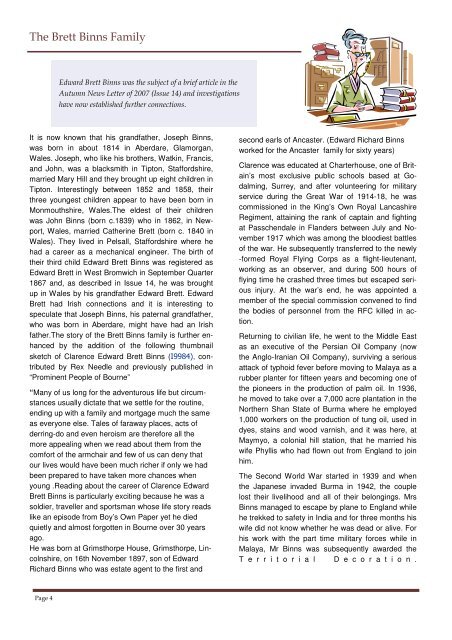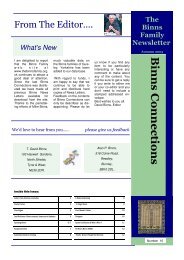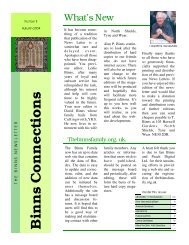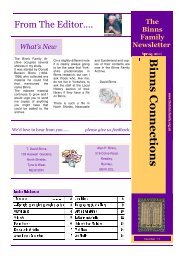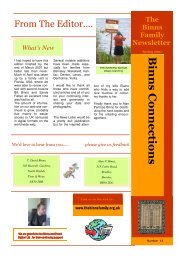Newsletter 17 .pub - The Binns Family
Newsletter 17 .pub - The Binns Family
Newsletter 17 .pub - The Binns Family
You also want an ePaper? Increase the reach of your titles
YUMPU automatically turns print PDFs into web optimized ePapers that Google loves.
<strong>The</strong> Brett <strong>Binns</strong> <strong>Family</strong><br />
Edward Brett <strong>Binns</strong> was the subject of a brief article in the<br />
Autumn News Letter of 2007 (Issue 14) and investigations<br />
have now established further connections.<br />
It is now known that his grandfather, Joseph <strong>Binns</strong>,<br />
was born in about 1814 in Aberdare, Glamorgan,<br />
Wales. Joseph, who like his brothers, Watkin, Francis,<br />
and John, was a blacksmith in Tipton, Staffordshire,<br />
married Mary Hill and they brought up eight children in<br />
Tipton. Interestingly between 1852 and 1858, their<br />
three youngest children appear to have been born in<br />
Monmouthshire, Wales.<strong>The</strong> eldest of their children<br />
was John <strong>Binns</strong> (born c.1839) who in 1862, in Newport,<br />
Wales, married Catherine Brett (born c. 1840 in<br />
Wales). <strong>The</strong>y lived in Pelsall, Staffordshire where he<br />
had a career as a mechanical engineer. <strong>The</strong> birth of<br />
their third child Edward Brett <strong>Binns</strong> was registered as<br />
Edward Brett in West Bromwich in September Quarter<br />
1867 and, as described in Issue 14, he was brought<br />
up in Wales by his grandfather Edward Brett. Edward<br />
Brett had Irish connections and it is interesting to<br />
speculate that Joseph <strong>Binns</strong>, his paternal grandfather,<br />
who was born in Aberdare, might have had an Irish<br />
father.<strong>The</strong> story of the Brett <strong>Binns</strong> family is further enhanced<br />
by the addition of the following thumbnail<br />
sketch of Clarence Edward Brett <strong>Binns</strong> (I9984), contributed<br />
by Rex Needle and previously <strong>pub</strong>lished in<br />
“Prominent People of Bourne”<br />
“Many of us long for the adventurous life but circumstances<br />
usually dictate that we settle for the routine,<br />
ending up with a family and mortgage much the same<br />
as everyone else. Tales of faraway places, acts of<br />
derring-do and even heroism are therefore all the<br />
more appealing when we read about them from the<br />
comfort of the armchair and few of us can deny that<br />
our lives would have been much richer if only we had<br />
been prepared to have taken more chances when<br />
young .Reading about the career of Clarence Edward<br />
Brett <strong>Binns</strong> is particularly exciting because he was a<br />
soldier, traveller and sportsman whose life story reads<br />
like an episode from Boy’s Own Paper yet he died<br />
quietly and almost forgotten in Bourne over 30 years<br />
ago.<br />
He was born at Grimsthorpe House, Grimsthorpe, Lincolnshire,<br />
on 16th November 1897, son of Edward<br />
Richard <strong>Binns</strong> who was estate agent to the first and<br />
second earls of Ancaster. (Edward Richard <strong>Binns</strong><br />
worked for the Ancaster family for sixty years)<br />
Clarence was educated at Charterhouse, one of Britain’s<br />
most exclusive <strong>pub</strong>lic schools based at Godalming,<br />
Surrey, and after volunteering for military<br />
service during the Great War of 1914-18, he was<br />
commissioned in the King’s Own Royal Lancashire<br />
Regiment, attaining the rank of captain and fighting<br />
at Passchendale in Flanders between July and November<br />
19<strong>17</strong> which was among the bloodiest battles<br />
of the war. He subsequently transferred to the newly<br />
-formed Royal Flying Corps as a flight-lieutenant,<br />
working as an observer, and during 500 hours of<br />
flying time he crashed three times but escaped serious<br />
injury. At the war’s end, he was appointed a<br />
member of the special commission convened to find<br />
the bodies of personnel from the RFC killed in action.<br />
Returning to civilian life, he went to the Middle East<br />
as an executive of the Persian Oil Company (now<br />
the Anglo-Iranian Oil Company), surviving a serious<br />
attack of typhoid fever before moving to Malaya as a<br />
rubber planter for fifteen years and becoming one of<br />
the pioneers in the production of palm oil. In 1936,<br />
he moved to take over a 7,000 acre plantation in the<br />
Northern Shan State of Burma where he employed<br />
1,000 workers on the production of tung oil, used in<br />
dyes, stains and wood varnish, and it was here, at<br />
Maymyo, a colonial hill station, that he married his<br />
wife Phyllis who had flown out from England to join<br />
him.<br />
<strong>The</strong> Second World War started in 1939 and when<br />
the Japanese invaded Burma in 1942, the couple<br />
lost their livelihood and all of their belongings. Mrs<br />
<strong>Binns</strong> managed to escape by plane to England while<br />
he trekked to safety in India and for three months his<br />
wife did not know whether he was dead or alive. For<br />
his work with the part time military forces while in<br />
Malaya, Mr <strong>Binns</strong> was subsequently awarded the<br />
T e r r i t o r i a l D e c o r a t i o n .<br />
Page 4


